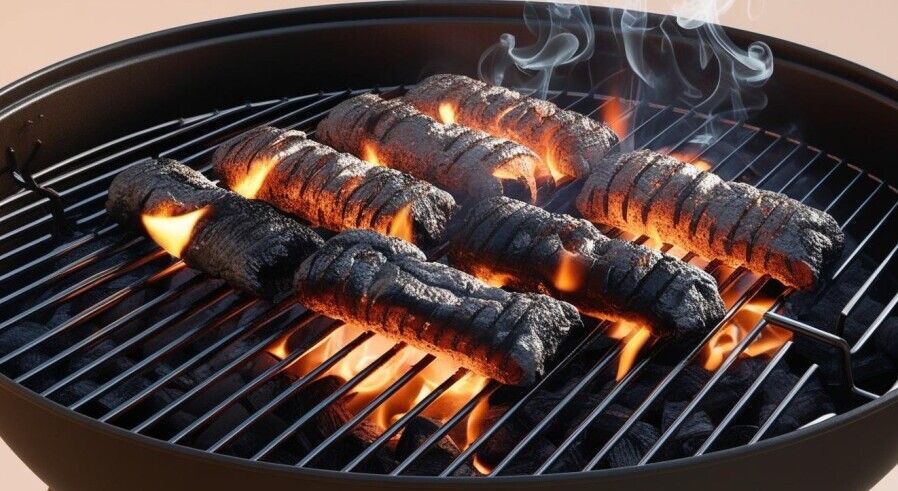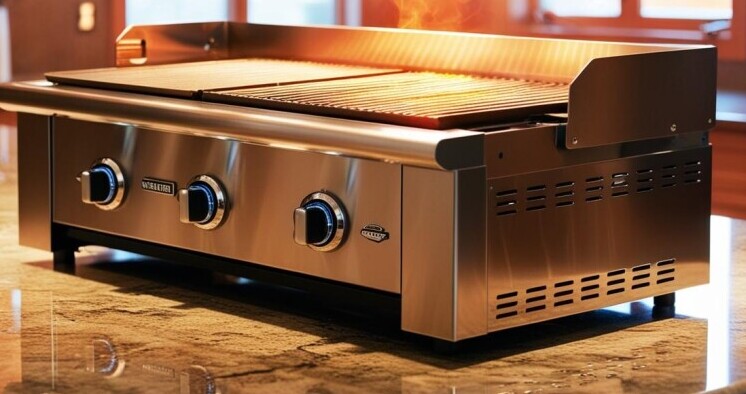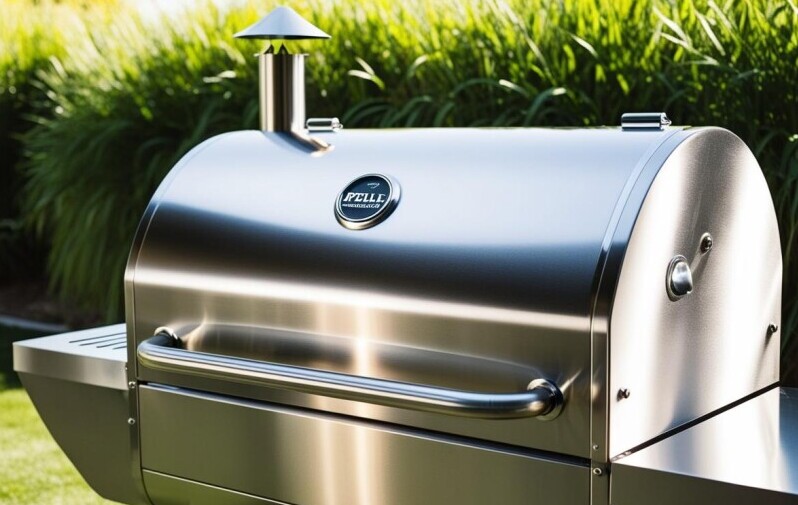Knowing Your Grills And Flavor Profiles
Grilling has come a long way from its humble beginnings. People have been cooking over open flames since forever, but now we have a bunch of choices when it comes to what we use to fuel our grills. You’ve probably heard of charcoal, gas, and electric grills. Each one brings something unique to the cookout, and picking the right fuel can really amp up your grilling game.
Charcoal enthusiasts love that smokey taste that adds depth and complexity to whatever they’re grilling. Gas grilling fans, on the other hand, dig the convenience and control it offers—no more waiting for coals to be just right. And let’s not forget about electric grills that are gaining popularity due to their ease of use, especially in urban settings where outdoor space is limited.
Choosing the right fuel isn’t just about taste though. You gotta think about how much effort you wanna put into it, how easy it is to clean up, and yeah, even the environment might sway your decision. So, let’s explore the unique vibes each of these fuels offer and see which one suits your style the best.
The Charcoal Experience: Flavor-Driven Grilling

Charcoal grilling is all about that all-time classic, smoky flavor. When meat sizzles over hot charcoal, it picks up that rich, smoky taste that just can’t be matched by other types of grilling. It’s the reason why so many grilling enthusiasts swear by fire and coals.
Not all charcoal is created equal, though. You’ve got your classic lumpwood, made from natural wood, which gives you a more intense flavor and burns hotter. Then there’s briquettes, which are kinda like compressed sawdust nuggets. They don’t burn as hot but last longer, making them more economical for longer grilling sessions. And for those who wanna skip right to the action without fussing over setup, instant-lighting charcoal is a nifty option.
But hold up, it’s not all fun and flavors. While charcoal grilling has a lot going for it flavor-wise, it demands a bit more work. Managing heat with charcoal means you’ve got to adjust vents and sometimes shuffle the coals around, kinda like keeping a campfire alive. It’s part of the thrill, though! Plus, clean-up can be a bit messy with leftover ash and all.
One way to stay safe when using charcoal is to use a charcoal chimney to start the charcoal. The easiest way is to have some paper loosely rolled and place the charcoal around it. Light the paper and watch it start your charcoal. It will take on average 15 – 20 minutes for your charcoal to be ready for grilling. After your charcoal has developed that gray ash color spread your charcoal out for maximum heat.
Safety is another thing to think about. Always store your charcoal in a cool, dry place and keep it away from anything that might ignite easily. Proper storage not only keeps you safe but ensures that your charcoal is ready to fire up anytime you want to grill.
Gas Grills: Efficiency and Convenience Combined

Gas grilling is the go-to for those who love efficiency and convenience when it comes to firing up the grill. It offers a smooth process to get things cooking right away without the wait you get with charcoal. Just twist a knob, fire it up, and you’re all set to start grilling!
When we’re talking gas grilling, there are two main types – propane and natural gas. Propane grills are portable, so they’re great for bringing the party wherever you want. If you’re okay sticking to one spot, natural gas could be your best bet with its residential connection, which means you never have to refill those propane tanks.
The biggest wins with gas grills are all about control and ease. Adjusting the temperature is super simple, making it a breeze to cook different types of food without burning or undercooking. Plus, gas burns cleaner than charcoal, so there’s less soot and ash to worry about. Might not have that deep smoky flavor, but it’s got enough flexibility to make searing and slow-cooking a delight.
On the flip side, there are some things to consider before going all-in on a gas grill. They can be a bit costlier upfront, and you need to keep safety in mind with the gas connections. Some folks also miss the traditional barbecue flavor that isn’t quite there with gas.
Still, if quick start-ups, easy temperature control, and less mess sound like your kind of grilling, then a gas grill is a strong contender to keep in mind.
Electric Grills: Flavor Without the Smoke

Electric grills have really grown on folks looking for simple, hassle-free grilling. They are great in the city or in places where outdoor grilling options are limited because they don’t produce smoke. Plug it in, and you’re grilling in no time.
One of the coolest things about electric grills is how techy they’ve become. Many models come with features like digital temperature control, timers, and even built-in thermometers. Some even offer non-stick grates, making cleanup a breeze. They’re great for quick meals any day of the week without the prep involved with other fuels.
As nifty as they are, electric grills do have some limitations. Given they depend on electricity, you can’t really take them wherever you like without a power source. Some grillers might find the flavor profile lacking the depth of traditional methods, as electric grills don’t impart a smoky taste like charcoal or subtle char from gas.
Despite that, if you’re after convenience, especially in an apartment setting, electric grills are a solid choice. They offer consistency and ease that’s perfect for those who are more about getting the food cooked without the fuss of flames and fuels. Why skip grilling when you can easily do it indoors too?
Pellet Grills Create Light Smokey Flavor

Pellet grills have come a long way since their inception. You can have that smokey flavor that you get with a charcoal grill but not as strong. There are a couple of things you will need for creating great meals with pellet grills: electricity and pellets.
The technology with pellet grills has improved drastically in the last 15 years. There are fewer problems with the fan motor and with the pellet dispenser. Manufacturers have worked tirelessly to overcome problems with the auger that pushes the pellets out for ignition. There are fewer clogged augers and fewer misfires.
The easiest way to prevent both of those problems is to keep your pellets dry and to clean your pellet grill on a regular basis. This helps prevent grease fires in your grill.
Since you will need to maintain your temperature at a specific level you have a control box that has probes attached to it to monitor the temperature inside your grill. That is one advantage over other grills, you can know within 10 degrees what the accurate temperature is. Also, with Bluetooth technology you can track the doneness of your meal with a probe inserted into the food you are cooking.
What Are Your Options?
After reviewing the types of grills that we have just discussed, you will need to make a decision about which type of grill suits your needs best.
You will need to consider where you live, how many people you will be grilling for, what flavor profile you prefer, how much you are willing to spend, and the space available.
Each of these factors needs to be answered. If you are just starting out I would recommend a grill that is inexpensive but allows you to learn how to build the flavor you prefer. It is okay to ask an experienced grilled for advice.
Jerry

Great breakdown of grilling options! Each type of grill definitely has its unique perks, and it’s interesting to see how personal preferences like flavor, convenience, and space play into the decision. For me, charcoal wins for that unbeatable smoky flavor, but I can see the appeal of gas or electric for a quick and easy setup. What’s everyone’s go-to grill and why?
Herman, charcoal is one of the oldest forms of grilling with the exception of grilling over an open flame. It is hard to say what is the most popular with everyone since the choices are so varied. Many people like the smokey flavor while others like the speed that gas and electric provide.
Jerry
This article helped me finally understand the differences between grilling fuels and choose the right one for my needs! I used to struggle with inconsistent temperatures and uneven cooking with charcoal, but after reading about the various methods of heat management, I’ve finally mastered it.
Now I use charcoal for larger gatherings where the smoky flavor is a must. Meanwhile, I’ve retained my gas grill for everyday use and appreciate its convenience. The section on electric grilling was also helpful – I’m considering getting a smaller electric grill for smaller portions or easy cleanup. Thanks for giving me some great ideas. 🙂
Dan, it sounds as if you will be taking advantage of both worlds. Gas is convenient for quick meals while charcoal or pellet take longer but brings about memories from days gone by.
Jerry
As someone who loves experimenting with barbecue, I found the comparison between charcoal, gas, and electric grilling really insightful. It’s great to see the pros and cons of each laid out so clearly. I’m leaning towards trying charcoal for that authentic smoky flavour, but the convenience of gas is tempting too. Thanks for helping me weigh up the options
Andrew, since you like to experiment with barbecue you will enjoy the smokey flavor of charcoal. It may take a bit longer for your food to be ready but the results are worth it. You will still have the convenience of gas if you should go that route.
Jerry
Hi there –
Like many people, I enjoy grilling during the spring, summer, and fall. I currently own a gas grill which is easy to use, requires minimal clean-up. The flavor profile is from the seasoning added to meat, poultry, or fish. However, I plan to buy charcoal and gas grill combo to enjoy the best of both worlds. Typically, I use lump wood, will have to experiment with briquettes.
Happy grilling
G
Godwin, you have a head start on many people by knowing what your favorite flavors are. You will be ahead of most people by purchasing the charcoal/gas combo. I would warn you to not overdo the lump charcoal at first since it burns hotter than regular charcoal.
Jerry
Great article, Jerry! You’ve really broken down the pros and cons of each grilling option in a way that’s easy to follow. I appreciate the practical tips, like using a charcoal chimney and keeping pellets dry for better results. The comparison of flavor profiles and convenience factors is super helpful for someone like me who’s still figuring out the best grilling style for my needs. Looking forward to exploring these options and firing up some tasty meals!
Loshane, my advice is to decide what your favorite flavor profile is and then learn to prepare that until you can do it without thinking. I would then start expanding my choices with new items and flavors as I gained more experience. I will be posting some tasty recipes in the near future.
Jerry
Hi Jerry,
The first thing that came to mind, was smoke. I have to have a smoky flavor to my meat. So, for me the electric grill is out. But I was wondering, couldn’t you put a smoker box with hickory chips on the grill to get your smoke flavor? I do that with my propane gas grill, and it works great. With the price of charcoal today, I am pretty well done with charcoal.
Another thought, can you put a probe meat thermometer with Bluetooth in a propane gas grill? I like that idea!
Last question, how do gas grills help with precise temperature control? I have not had much luck with controlling the temperature on my gas grill. Do you just turn the dials up or down until you hit the temperature you want?
Thanks,
Mark
Mark, you can still get that smokey flavor on an electric grill. You will use the same technique as on a propane grill. There are Bluetooth thermometers that can used on a propane grill allowing you that precise temperature you are looking for. To get that perfect temperature on a propane grill, you will need to adjust the temperature up or down in the beginning until you get it where you want it.
Jerry
This guide gives important information for individuals seeking to select the suitable barbecuing fuel. The breakdown of advantages and disadvantages for charcoal, gas, and electric grills makes it easier to pick according to personal preferences and cooking needs. In my opinion, charcoal passes on a wonderful great smoky preference to food, while gas uses ease and precise control. Barbecue grill are suitable for indoor cooking, yet they may not deliver the very same authentic grilling ambiance as charcoal or gas.
I wonder concerning temperature control when utilizing charcoal – it can be challenging to preserve a consistent heat level, specifically throughout extended food preparation periods. Additionally, I would certainly like to understand if there are any kind of techniques for achieving a rich, great smoky taste with gas or electric grills, or if charcoal is the only method to genuinely record that authentic preference.
In general, this message provides great understandings right into the different barbecuing gas offered, and the suggestions you have actually shared will absolutely assist anybody select the ideal gas for their barbecuing style. Many thanks for sharing such useful details!
Mr. Cool there are ways to achieve that smokey flavor with gas or electric. I have taken a small pan placed my wood chips in the water and placed it on the end of the grill. Allow the pan to begin to smoke before putting your food on to grill. The smokey flavor will not be as strong as it would be on a charcoal or pellet grill but it would still be present. It will take some time to learn this technique but you will be satisfied with the results.
Jerry
Hey, Jerry,
This is a great piece on grilling. I didn’t know the word until I was reading through this article. However, I was asking my cooks at a restaurant [where I always eat whenever I want to] if they could consider grilling (fry meats) since I felt like to eat such but there was none, especially at Blue Restaurant in Juba, South Sudan.
The owner [lady] looked at me with a wide smile in her face. I said, “Give it a try and you’ll thank me later,” and I then asked for a roasted half chicken instead. But from the look, she felt like I was joking. She doesn’t have customers in mind for a grilled meat apart from chicken. They use charcoal for roasting chickens.
The four (4) types of grills you mentioned and discussed are all unique in their own eyes. I’d prefer the first because of the connection with fire. We have been roasting fish when I was a kid, back in the village, but I never seen or tasted such for the last 2 decades because I now live in town. However, the rest are modernized and might have better ‘cookouts’ than the first. I just don’t know the differences.
What is your favorite(s)?
John
John, you are fortunate indeed to have someone who introduced you to roasted chicken. Charcoal has been the standby for centuries when it comes to grilling. You will need to experiment with the different types of grills to find the one that suits your needs the best. My advice is to read different articles and even cookbooks to begin understanding the good and bad points of each.
Since you have a history of using charcoal for different foods that may be the one that is best suited for you. However, if you live in an apartment complex you will need to check with the manager to be certain that grilling is allowed in the complex.
Jerry
The exploration of different grilling fuels in this article opens up a deeper conversation about how the choice of fuel shapes not just the flavor but the entire grilling experience. Charcoal often takes the spotlight for its rich, smoky undertones, but it also demands patience and skill—a rewarding challenge for those who view grilling as an art form. On the other hand, gas and electric grills bring efficiency and convenience, making them ideal for weeknight meals or urban settings where space and time are at a premium.
What I found interesting is how sustainability and environmental impact factor into the equation. As more people become conscious of their carbon footprint, could we see a shift toward hybrid solutions, such as electric grills powered by renewable energy sources or eco-friendly charcoal made from agricultural waste?
It’s also worth noting how the choice of fuel might influence culinary creativity. For instance, does the versatility of gas or electric grills encourage experimentation with a wider variety of cuisines and techniques? Or does the tradition and ritual associated with charcoal grilling inspire a deeper connection to the process itself?
The Investor, you have raised some very important questions about which type of grill allows you to experiment in the ways you prefer. You will need to develop patience for any type of grilling since there are different types of dishes that will need a longer time to cook. That is why some of the propane grills have a burner to one side on the outside of the grill. Tradition will always play a part in your grilling regardless of the grill.
Jerry
This post is a fantastic primer for anyone looking to navigate the wide world of grilling. The breakdown of grill types—charcoal, gas, electric, and pellet—along with their unique characteristics, offers valuable insights for grilling enthusiasts of all levels. Each section dives into the pros and cons of the fuel options, helping readers align their grilling style with their personal preferences and practical needs.
The emphasis on flavor profiles is particularly helpful, as it highlights how the choice of fuel can directly impact the taste of food. From the rich, smoky undertones of charcoal to the clean convenience of electric grills, this post caters to a variety of tastes and lifestyles. I also appreciate the attention to safety and maintenance tips, such as proper charcoal storage, grease fire prevention, and keeping pellets dry. These practical nuggets ensure that readers can grill with confidence and care.
The inclusion of newer technologies, like Bluetooth in pellet grills, underscores how grilling has evolved. It’s exciting to see how innovation meets tradition in this realm. Overall, this post inspires thoughtful decision-making for an enjoyable and flavorful grilling experience.
Andrejs, I have found most people like grilled food. The most common thread I have found about grilling is which grill to use. Those who like speed prefer gas grills while those who like smokey flavors prefer either charcoal or pellet grills. Most people when they have found the flavor profile they prefer don’t want to change to another type of grill.
Jerry
Wow, I actually never heard of using a charcoal chimney. I’ve only used lighter fluid. In my opinion, charcoal is king because of that smokey flavor. It is worth the wait. You introduced me to other types of grills I never heard of like the pellet grill that has the unique feature of having the internal probes to let you know the temp at any time. Even though I am and always will be a charcoal BBQ fan, I can also see the pros of the other grill types too like not having the wait charcoal does. Thanks for introducing me to other ways to grill
Jason, I started using a chimney about 10 years ago and found it to be very beneficial. A chimney helps speed up the process since everything in a smaller contained and will ignite faster. This also allows you time to put the finishing touches on the food your are preparing.
Jerry